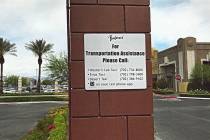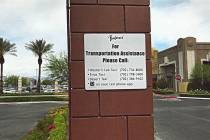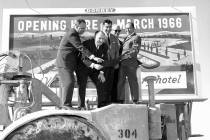Spending habits about to catch up with library district
Louie Overstreet and Jamie Costello resigned as board members of the Las Vegas-Clark County Library District in 2008, uneasy about some of the board’s spending decisions — decisions advocated by the district’s top administrator, Daniel Walters. Turns out, they had good cause to worry. The recession had started in December 2007.
Now the library district is facing an $11 million deficit, and that’s not allowed by law.
At today’s 6 p.m. board meeting at the Clark County Library, the new executive director, Jeanne Goodrich, will ask the board for permission to offer buyouts to eligible workers. About 90 of the more than 700 district employees would be eligible for voluntary separations.
Teamsters union Local 14 represents many library employees, and the board will go into executive session tonight to discuss the possibility of seeking union concessions.
Layoffs are also possible because 58 percent of the budget is personnel cost.
Goodrich, who started in June, drew the short straw. She joined a library district that once had plenty of money from its share of ever-increasing property and sales taxes.
The board, whose 10 members are appointed by city and county officials, watched joyfully as revenues steadily increased. Millions not needed for operating costs were shifted into a fund for capital construction. That was how the district was able to pay cash for the $20 million Centennial Hills Library, which opened in January 2009, though voters six years earlier had said no to bonds for new libraries.
In 2003, voters strongly rejected a $52 million bond question to build four libraries and increase operating costs by 29 percent. Faced with a growing population, library officials did an end run and kept on spending and building while times were flush during Walters’ decade-long tenure as executive director.
Before Walters retired, he won board approval (over the objections of Overstreet and Costello) for the Windmill Library and Service Center. Cost: $50 million. It should open in 2011, but whether the district will have enough money to staff it remains an unanswered question, Goodrich said.
This wasn’t a problem of Goodrich’s making, but she’s the one left mopping up and looking for places to cut.
The library consistently spends 20 percent of its budget on materials used by patrons. But the $12 million spent on that is now going down to $5 million, she predicted. Because the first cutbacks were made in November and many materials already had been ordered, Goodrich said, library patrons might not feel the cuts yet.
But they will. Fewer new books, movies and music are the most obvious. Little-used computer databases will be gone. Top-tier author appearances will dwindle. Publications such as Highlights won’t be mailed out or look so appealing.
Some cuts are overdue. It took a financial crisis for the district to discover that 10 percent of all of the materials purchased in the past 18 months had not been checked out in the past six months. Not exactly smart spending there.
Overstreet, a board member for nearly eight years, blames Walters and some indifferent or unsophisticated board members. He wouldn’t name names but said a few members wouldn’t even open their meeting packets until they arrived at the meeting. Some were “totally uninformed and unprepared for financial analysis.”
“A lot of people will get hurt in this process because of shortsightedness,” the retired engineer said.
In fairness, the library district board wasn’t the only one that over-projected revenues the past few years, relying on financial advisers and joining the Rosie Scenario Club.
Tonight, as board members discuss how to save money by pushing employees out the door, some might want to ask themselves: How did we get here? What’s my responsibility?
Jane Ann Morrison’s column appears Monday, Thursday and Saturday. E-mail her at Jane@reviewjournal.com or call (702) 383-0275. She also blogs at lvrj.com/blogs/morrison.












